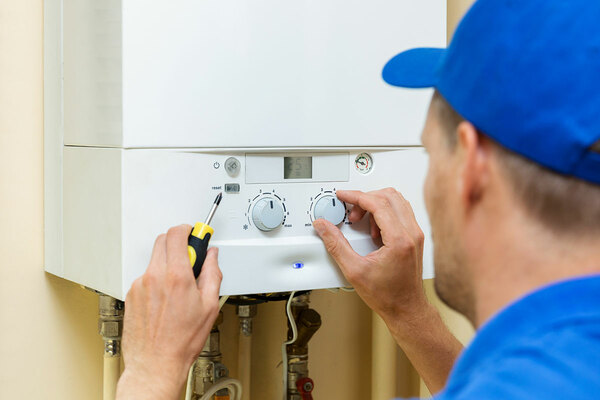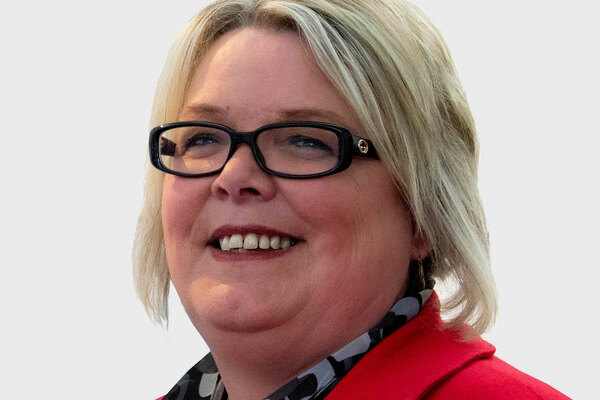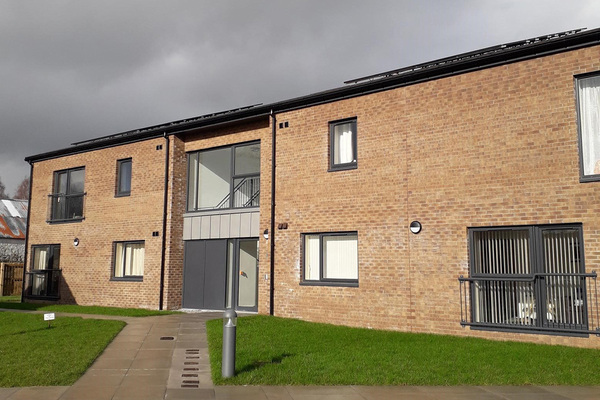Harnessing compliance data is the route to dealing with ‘no access’ issues during COVID-19, case studies suggest
Ann Lucas, chair of Tower Hamlets Homes, discusses transforming safety compliance by better managing data
In association with:

All social housing providers collect, store and process large quantities of data every day. The question most must address is how best to use that data to meet priorities and challenges. We need to leverage the data we collect to streamline and efficiently manage the services we deliver to our residents. This involves harnessing data analytics, structured databases and predictive forecasting routines.
Managing compliance across a varied portfolio of properties and residents presents a significant challenge. Compliance has many aspects, the complexities of which vary according to the stock and tenures being managed.
Some relate primarily to the fabric of services provided to blocks, and can be largely based on asset management data and systems. But others relate to individual dwellings and are thus affected by both the form of tenure and the needs or behaviour of the occupants. Providers have different responsibilities for, and different rights of access to, tenanted and leasehold properties, although a failure in a leasehold unit can compromise the safety of the entire block.
The use of data can play an instrumental part in meeting compliance objectives, whether monitoring current compliance or using predictive analysis to mitigate issues before they arise.
The largest hurdle to overcome is ensuring the data we hold is accurate and up to date. There are essentially two divergent strands of data that need consideration. Both are subject to change, but each presents uniquely different management challenges.
The first strand is property and asset data – for example, boiler ages, installation years, types, and actual service and due dates. All of this data changes – in the case of gas boilers, through the annual servicing regime and replacement programmes.
However, this can be ‘owned’ by the provider, provided there are robust processes and associated management systems. The service dates can be automated to reduce human intervention and ensure the data in the system is up to date and accurate.
Similarly, when an asset replacement programme is being undertaken, this data can be fed into the asset management system to ensure the asset list is accurate and forecast future replacement cycles.
The second strand, people data, is subject to significantly more churn and flux. Numerous “unknown” changes can be happening every day. However, it is invaluable for providing customer insight and in predictive analysis of future compliance issues. It is a priority to update this data to ensure it is accurate, through contact with residents – whether through phone conversations, tenant apps or other means.
We must also be able to share with the fire service data about the households in higher risk blocks. We can only do this by having up-to-date and accurate data about who resides in our properties and any particular needs they might have. For example, if someone has mobility issues, they might be unable to follow an evacuation plan.
Maintaining up-to-date data about residents is difficult enough with tenanted dwellings, but it is even harder with owner-occupied leasehold properties and nigh on impossible with sublet leasehold units.
But the cross-correlation of property and people data can provide a way to predict potential compliance issues. A history of ‘no access’ for gas servicing suggests there may be access difficulties in future; a resident advising of a change in their mental health may warrant more personal attention to gain access, working with their carers or support workers early to mitigate any potential compliance breach. Cross-referencing this data with asset information can maintain residents’ safety.
Most organisations run a gas safety programme that looks to the next service appointment. Access to historical records, accurate asset information and resident data will allow for the prediction of future compliance issues. This has become even more vital over the past few months, following the outbreak of coronavirus. It is reasonable to assume that older residents and those suffering from an underlying health condition are likely to be shielding or self-isolating. These factors referenced against the next service date can help to predict potential obstacles to compliance.
There are substantial issues around maintaining accurate data, particularly data associated with people. Ensuring it is kept up to date, accurate and compliant with GDPR legislation is one of the great challenges for all housing providers. Accurate asset records are a lesser challenge, but without strict data management processes and update routines it is easy for this to lapse and become out of date.
The cross-correlation of these disparate data sources presents an opportunity to predict compliance risks. Ultimately, if you know your properties and know your people, you can understand and plan for the risk.
Waking up to the value of data for compliance
Barnsbury has homes in Islington, north London, including these in Barnsbury Street
Three housing associations operating across the UK have found that they need to better understand and manage their gas maintenance needs – and are now using Gas Tag technology to do it
Barnsbury Housing Association
Size: 300 homes
Barnsbury Housing Association is the archetype of a small, community-based housing association. When Susan French became chief executive in 2016, she encountered the advantages of such a set-up, as well as its challenges.
“There are lots of amazingly good things about being small and community-based,” says Ms French. “But we had to make sure we were in the 21st century.”
In large part, that meant improving IT and data, not least on gas compliance. The association, which has 300 homes all within or adjacent to Barnsbury in Islington, north London, has long-standing relationships with a handful of small contractors – another advantage afforded by its size and being community-based.
When it comes to gas, the service comes from a sole trader who runs a business his father ran before him. The relationship with tenants is accordingly strong. But keeping accurate data about what work had been carried out, where and when, wasn’t always easy.
“We had members of staff keeping records on spreadsheets and a small gas contractor, where the admin support could be a challenge. But the service being given to us and tenants was fantastic.”
Barnsbury also has homes in Highbury Fields, Islington, north London
Evidencing occasions where access wasn’t possible was a particular problem. “We’d find Post-It notes stuck to things – ‘Tried to knock, wasn’t in’ – and keeping that audit trail was a real headache.”
It is a problem that has been addressed by using Gas Tag’s technology. Every gas meter in the association’s homes now has a small tag attached to it. The engineer scans the tag to enter details of the work completed, which is then automatically uploaded to a cloud-based web system. Certificates are also issued automatically.
“It’s seamless between the contractor and us. I can log in and be really clear about the position,” she says. “It helps reduce the admin burden for the contractor and makes things a lot more transparent for us, which makes us more efficient.”
Manningham Housing Association
Size: 1,400 units
“Housing is now waking up to this whole idea that data is critical,” says Barrington Billings, chair of Manningham Housing Association. “We’ve been sitting on data for years, but we haven’t been capturing it properly, we haven’t been collating it properly, and we haven’t been analysing and utilising it effectively.”
That includes, he says, gas compliance, which was an area of particular concern at Manningham. When he took up the post in 2017, the Yorkshire association had been downgraded to ‘G3’ for governance. The regulator was particularly keen to see improvement in gas compliance.
Mr Billings says that what was clear was “strategically, we couldn’t make certain decisions unless we had quick and accurate data”.
To achieve that for gas compliance, Manningham decided to invest in Gas Tag’s technology and has attached its small tags to all its gas meters. Engineers scan these tags using their smartphones and an app to enter details of the work completed. The app can also add a geo-tagged photo stamped with the time and date when it hasn’t been possible to gain access to a property, providing crucial and timely information about which homes could not be accessed. All the data can be viewed in real time on a web-based system.
“We can call up a property, see as soon as the engineer is on site and get live, up-to-the-minute information. We have more confidence in what we are being told by the engineers because we can verify it very, very quickly – almost instantaneously.”
Even in the midst of the lockdown, not a single gas service has been missed. “Because we’ve got such a tight system, it’s helped us to manage information so effectively that we were able to still get into all our properties during the lockdown and still get things done. The speed at which we could get information, the way we could analyse it and keep in touch, and then digitally move that information on to other departments was a big help.”
The 2,500-home Loreburn Housing Group hopes to use Gas Tag across all its properties, including this Carnation Crescent development
Loreburn Housing Group
Size: 2,500 homes
In April 2019, Loreburn Housing Group had an independent audit of its gas policies and procedures. One of the key recommendations was that the association, which has 2,500 properties in the Dumfries and Galloway region of south-west Scotland, should introduce an electronic system to store all its gas data in one place.
“Our compliance data was already stored digitally but it sat across a variety of systems,” explains Nadine Paterson, the association’s assistant manager (compliance and projects).
“Our aim was to streamline the process and to hold the information in one place.”
It is why the association has now signed a contract for a new digital system that will ensure all information is stored in one place.
The hope is that Gas Tag will make it easier to safeguard customers, demonstrate compliance and more accurately predict when and where future investment is required.
“With real-time data about how our boilers are performing, we are better positioned from both a compliance and repairs perspective,” says Ms Paterson. “We will be able to predict when problems are likely to happen which enables us to plan more effectively and adopt a proactive approach.”
“There are now much easier ways to gather information, allowing for much deeper analysis”
Peter Luke, commercial director, Gas Tag
It involves liaison across different groups of staff and independent contractors across multiple areas of compliance. It may involve a variety of spreadsheets, potentially pulling information from several different systems. This can be cumbersome and fail to provide a true sense of the compliance picture – it may only be possible to know if an inspection has been carried out.
Making proactive decisions also becomes very difficult. It is helpful to know if gaining access for a gas inspection is difficult on certain days of the week, for example. But that requires the contractor to inform the association and the information to then be recorded on a spreadsheet, which may not be easy to analyse the next time an inspection is due.
However, there are now much easier ways to gather information, allowing for much deeper analysis, better decisions and increased customer satisfaction.
At Gas Tag, we have been working with housing associations to develop comprehensive and timely databases on compliance. Our work on gas involves affixing a small tag on meters, which the engineer scans. That engineer can record all the work carried out, using a smartphone app, and certificates can be issued automatically. Where it’s not been possible to gain access, a time and geo-stamped photo is taken. We’ve also added functionality that makes it possible to record properties in which a resident is self-isolating and access may not be immediately possible.
All this information goes into a central database, where it can be seen and assessed – in real time – by contractors and compliance teams alike. This means there’s more information than ever on both safety and on likely areas for extra attention and investment.
We entered the sector with a data-driven solution for gas compliance, but we are already adapting our technology into all areas of compliance, with products available for fire door safety and cyclical maintenance and repairs. Our hope is that by so doing, more and more associations will be able to make informed decisions about how best to keep their tenants safe.

















